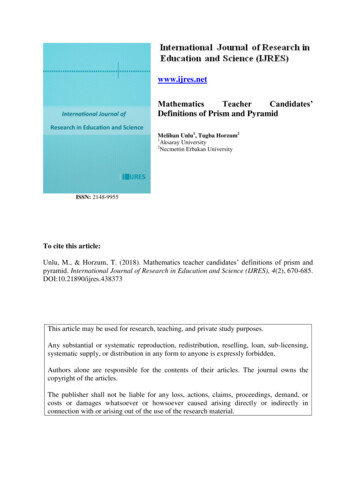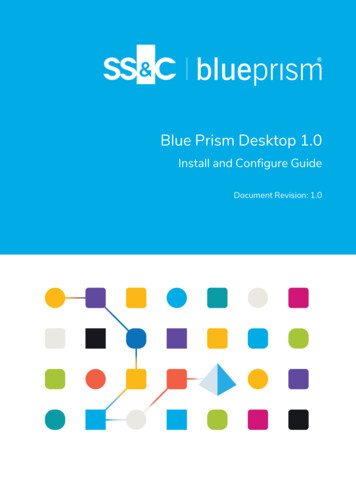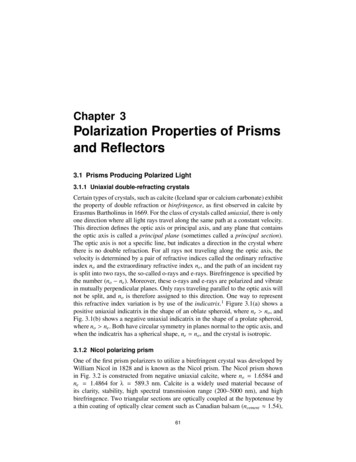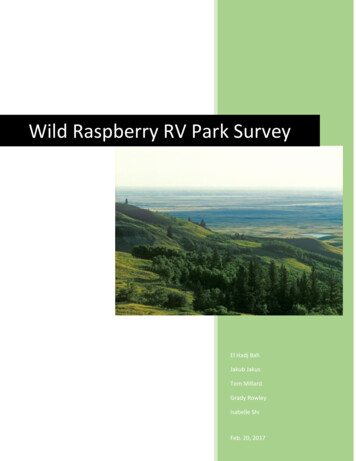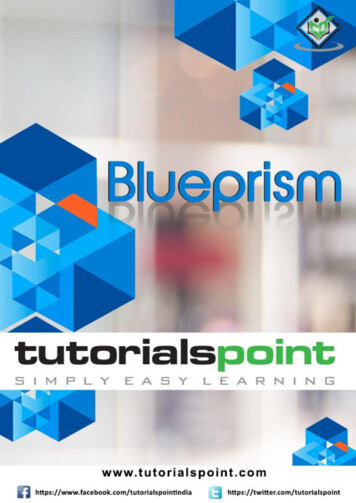
Transcription
PRISM and an Agenda for European NetworkSecurity ResearchAnother Turn of the Wheel: Mainframe, Desktop, Cloud, PeerChristian GrothoffTechnische Universität München26.08.2013“Never doubt your ability to change the world.” –Glenn Greenwald
Everybody Has SecretsIBusiness & Trade SecretsIPolitical opinionsIIllegal activities
Keeping SecretsIEncryption: baselineIHide meta-data: state of the artIPractice today?
Keeping SecretsIEncryption: baselineIHide meta-data: state of the artIPractice today?Send everything to US in plaintext
IGuardian: “The PRISM program allows the intelligenceservices direct access to the companies servers.”ICooperating providers: Microsoft, Yahoo, Google, Facebook,PalTalk, YouTube, Skype, AOL, Apple
IGuardian: “The PRISM program allows the intelligenceservices direct access to the companies servers.”ICooperating providers: Microsoft, Yahoo, Google, Facebook,PalTalk, YouTube, Skype, AOL, AppleIPRISM enables real-time surveillance and access to storedcontentIData collected: E-mails, instant messages, videos, photos,stored data (likely files), voice chats, file transfers, videoconferences, log-in times, and social network profilesITiny part of NSA: 20 M budget
US discussion focuses on spying on US citizens and legality underUS law.Frank Church (D-Idaho):“The NSA’s capability at any time could be turned around on theAmerican people, and no American would have any privacy left,such is the capability to monitor everything: telephone conversations, telegrams, it doesn’t matter.”
INSA’s tool to track global surveillance dataI2,392,343,446 records from the USI97,111,199,358 records worldwideIThis is for March 2013 alone
INSA’s tool to track global surveillance dataI2,392,343,446 records from the USI97,111,199,358 records worldwideIThis is for March 2013 aloneIGermany most surveilled country in Europe
INSA’s tool to track global surveillance dataI2,392,343,446 records from the USI97,111,199,358 records worldwideIThis is for March 2013 aloneIGermany most surveilled country in EuropeI“leverages FOSS technology”
Other ProgramsI“The SIGAD Used Most in NSA Reporting” there are more SIGINT toolsIPresentations list FARVIEW and BLARNEYIMonitor fiber cables and infrastructure(IXPs?)I“NSA collecting phone records of millions ofVerizon customers daily” –Guardian
Other ProgramsI“The SIGAD Used Most in NSA Reporting” there are more SIGINT toolsIPresentations list FARVIEW and BLARNEYIMonitor fiber cables and infrastructure(IXPs?)I“NSA collecting phone records of millions ofVerizon customers daily” –GuardianWe do not know all about PRISM. Repr. Sanches (D-Calif.), afterlearning more during a briefing, said there is“significantly more than what is out in the media today (.) I believeit’s the tip of the iceberg.”
History: Irak WarKatharine Gun leaked memo from NSA agent Frank Koza in 2003about an American effort to monitor the communications of six delegations to the United Nations who were undecided on authorizingthe Iraq War and who were being fiercely courted by both sides:“As you’ve likely heard by now, the Agency is mounting a surge particularly directed at the UN Security Council (UNSC) members (minusUS and GBR of course) for insights as to how to membership is reactingto the on-going debate RE: Iraq, plans to vote on any related resolutions, what related policies/negotiating positions they may be considering, alliances/dependencies, etc — the whole gamut of information thatcould give US policymakers an edge in obtaining results favorable toUS goals or to head off surprises. In RT, that means a QRC surge effortto revive/create efforts against UNSC members Angola, Cameroon, Chile,Bulgaria and Guinea, as well as extra focus on Pakistan UN matters.”
CyberwarPresidential Policy Directive 20, issued October 2012 and releasedby Edward Snowden, outlines U.S. cyberwar policy:“Offensive Cyber Effect Operations (OCEO) can offer unique and unconventional capabilities to advance U.S. national objectives around theworld with little or no warning to the adversary or target and with potential effects ranging from subtle to severely damaging. (.)The United States Government shall identify potential targets of nationalimportance where OCEO can offer a favorable balance of effectivenessand risk as compared with other instruments of national power, establishand maintain OCEO capabilities integrated as appropriate with other U.S.offensive capabilities, and execute those capabilities in a manner consistentwith the provisions of this directive.”
Technical CooperationBloomberg reports:IUS companies provide internal information to US secretservicesICompanies from software, banking, communications hardwareproviders, network security firmsIIncluding technical specifications and unpatched softwarevulnerabilitiesIIn return, these US companies are given access tointelligence informationIPartners include: Microsoft, Intel, McAfee
History: ECHELONISIGINT collection networkof AU, CA, NZ, UK and USIBaltimore Sun reported in1995 that Airbus lost a 6billion contract in 1994 afterNSA reported that Airbusofficials had been bribingofficials to secure thecontract.IUsed to facilitate KenetechWindpower’s espionageagainst Enercon in1994-1996.Former US listening station at Teufelsberg, Berlin.
Does it matter?MPI estimated losses due to industrial espionage damagein 1988 at DM 8 billion.So how does the EU react to learning about PRISM?
Does it matter?MPI estimated losses due to industrial espionage damagein 1988 at DM 8 billion.So how does the EU react to learning about PRISM?“Direct access of US law enforcement to the data of EU citizenson servers of US companies should be excluded unless in clearlydefined, exceptional and judicially reviewable situations.”–Viviane Reding, EC vice-president in response to PRISM
Not Just MonitoringIUS controls key Internet infrastructure:IIIIIINumber resources (IANA)Domain Name System (Root zone)DNSSEC root certificateX.509 CAs (HTTPS certificates)Major browser vendors (CA root stores!)Encryption does not help if PKI is compromised!
Political Solutions?Ron Wyden (US Senateintelligence committe) askedJames Clapper, director ofnational intelligence in March2013:“Does the NSA collect anytype of data at all on millionsor hundreds of millions ofAmericans?”Clapper replied:“No, sir.”.
The Enemy Within“In February, the UK based research publication Statewatch reportedthat the EU had secretely agreed to set up an international telephone tapping network via a secret network of committees established under the “third pillar” of the Mastricht Treacty covering cooperation on law and order. (.) EU countries (.) should agree oninternational interception standards (.) to co-operate closelywith the FBI (.). Network and service providers in the EU will beobliged to install tappable systems and to place under surveillanceany person or group when served an interception order. These planshave never been referred to any European government for scrutiny(.) despite the clear civil liberties issues raised by such an unaccountable system. (.) The German government estimates that themobile phone part of the package alone will cost 4 billion D-marks.”Scientific and Technological Options Assessment (STOA), “An Appraisal of Technologies of Political Control”,European Parliament, PE 166499, 6 January 1998.
Technical SolutionsCan we develop technologies to solve problems created by technology?
Technical SolutionsCan we develop technologies to solve problems created by technology?IHack back?
Technical SolutionsCan we develop technologies to solve problems created by technology?IHack back?IMove data to European cloud?
Technical SolutionsCan we develop technologies to solve problems created by technology?IHack back?IMove data to European cloud?IDecentralize data and trust!
Decentralize EverythingIEncrypt everything end-to-endIDecentralized PKIIDecentralized data storageINo serversINo authorities
Decentralize EverythingIEncrypt everything end-to-endIDecentralized PKIIDecentralized data storageINo serversINo authorities No juicy targets for APTs
Decentralized vs. CentralizedDecentralized:SlowerNo economics of scaleMore complex to useMore complex to developHard to secureHard to evolveCentralized:
Decentralized vs. CentralizedDecentralized:SlowerNo economics of scaleMore complex to useMore complex to developHard to secureHard to evolveCentralized:Compromised
My Research and Development AgendaMake decentralized systems:IFaster, more scalableIEasier to develop, deploy and useIEasier to evolve and extendISecure (privacy-preserving, censorship-resistant, available, .)
Our PEthernetPhys. Layer
Our PEthernetPhys. LayerHTTPS/TCP/WLAN/.
Our PEthernetPhys. LayerCORE (ECDHE AES)HTTPS/TCP/WLAN/.
Our PEthernetPhys. LayerR 5 N DHTCORE (ECDHE AES)HTTPS/TCP/WLAN/.
Our PEthernetPhys. LayerMesh (ECDHE AES)R 5 N DHTCORE (ECDHE AES)HTTPS/TCP/WLAN/.
Our PEthernetPhys. LayerGNSMesh (ECDHE AES)R 5 N DHTCORE (ECDHE AES)HTTPS/TCP/WLAN/.
Our PEthernetPhys. LayerRegEx/PSYCGNSMesh (ECDHE AES)R 5 N DHTCORE (ECDHE AES)HTTPS/TCP/WLAN/.
Our PIP/BGPEthernetPhys. LayerRegEx/PSYCGNSMesh (ECDHE AES)R 5 N DHTCORE (ECDHE AES)HTTPS/TCP/WLAN/.
Decentralized Naming Systems1aphtogremUR onLs ersSecureGlobalHierarchical RegistrationMemorableZooko’s Triangle1Joint work with Martin Schanzenbach and Matthias Wachs
The GNU Name System (GNS)Decentralized PKI that can also replace DNS/DNSSEC:ISigned Resource Records (RRs)ISecure delegation provides transitivity (SDSI)IDecentralized resolution (R 5 N DHT)IEvery user manages his own zone
Zone Management: like in DNS
Name resolution in GNSIBob wants to be called bobIBob can reach his webserver via www.gnu
Secure introductionBob Builder, Ph.D.Address: Country, Street Name 23Phone: 555-12345Mobile: 666-54321Mail:bob@H2R84L4JIL3G5C.zkeyIBob gives his public key to his friends via QR code Bob’s friends can resolve his records via *.petname.gnu
DelegationIAlice learns Bob’s public keyIAlice creates delegation to zone bobIAlice can reach Bob’s webserver via www.bob.gnu
Name Resolution1www.bob.gnu?Local Zone2.'bob'bob3A: 5.6.7.854DHTPKEY, KpubBobGET www, KpubBobPKEY.BobKpub
GNS as PKI (via DANE/TLSA)
Query Privacy: TerminologyG generator in ECC curve, a pointn size of ECC group, n : G , n primex private ECC key of zone ( Zn )P public key of zone, a point P : xGl label for record in a zone ( Zn )RP,l set of records for label l in zone PqP,l query hash (hash code for DHT lookup)BP,l block with information for label l in zone P publishedin the DHT under qP,l
Query Privacy: CryptographyPublishing B under qP,l : H(dG )h : H(l, P)(1)d : h · x mod n(2)BP,l : Sd (EHKDF (l,P) (RP,l )), dG(3)
Query Privacy: CryptographyPublishing B under qP,l : H(dG )h : H(l, P)(1)d : h · x mod n(2)BP,l : Sd (EHKDF (l,P) (RP,l )), dG(3)Searching for l in zone Ph H(l, P)(4)qP,l H(dG ) H(hxG ) H(hP) obtain BP,l(5)RP,l DHKDF (l,P) (BP,l )(6)
GNS for GNUnetProperties of GNSIDecentralized name system with secure memorable namesIDecentralized name system with globally unique, secureidentifiersIQR codes for introduction, delegation used to achievetransitivityIAchieves query and response privacy except againstconfirmation attackICan provide alternative PKI, validate TLS via TLSA recordsUses for GNS in GNUnetIPseudonymous file-sharingIIP services in the P2P network (P2P-VPN) via “VPN” recordsIIdentities in social networking applications
Our PIP/BGPEthernetPhys. LayerRegEx/PSYCGNSMesh (ECDHE AES)R 5 N DHTCORE (ECDHE AES)HTTPS/TCP/WLAN/.
The Evolution Challenge2IFeatures are frequently added to social applicationsISome require changes (“extensions”) to data formats andmessagesICentralized, browser-based networks can easily update to newversionIDecentralized systems must transition gracefully2Joint work with Carlo v. Loesch and Gabor Toth
Related Work: XMLIExtensible Markup LanguageISyntax is extensibleIExtensions have no semantics
PSYCWe are working on PSYC2, the successor to PSYC:IMore compact, mostly human-readable, faster-to-parserelative of XML/JSON/XMPPIPSYC messages consist of a state update and a methodinvocationPSYC includes interesting ideas for social networking:IIIIIStateful multicastHistoryDifference-based updatesPSYC addresses extensibility problem using try-and-slicepattern
PSYC State: ExampleThe PSYC state is a set of key-value pairs where the names of keysuse underscores to create an inheritance relationship:InameIname firstIname first chineseIaddressIaddress streetIaddress countryThe data format for each state is fixed for each top-level label.
PSYC Methods: ExampleA PSYC method has a name which follows the same structure askeys:ImessageImessage privateImessage publicImessage public whisperImessage announcementImessage announcement anonymousMethods have access to the current state and a per-message bytestream.
The Try-and-Slice Patternint msg (string method) {while (1) {switch (method) {case " notice update news": // handle news updatereturn 1;case " notice": // handle generic noticereturn 1;case " message": // handle generic messagereturn 1;// .}int glyph strrpos (method, ’ ’);if (glyph 1) break;truncate (method, glyph);}}
Advantages of Try-and-SliceIExtensible, can support many applicationsICan be applied to state and methodsDefines what backwards-compatible extensibility means:IIICan incrementally expand implementations by deepeningcoverageIncompatible updates introduce new top-level methods
PSYC2 for GNUnetProperties of PSYCICompact encoding (much smaller than XML/JSON/XMPP)ISupports stateful multicastISupports message history (replay, see latest news, etc.)IExtensible syntax and semanticsUses for PSYC2 in GNUnetIP2P social networking foundation (combine with GNS!)IPushes social profiles (state) to all recipients, no federationIReplay from local database used as primary access methodIMy data is stored on my machineIUse secure multicast to support very large groups
Our PIP/BGPEthernetPhys. LayerRegEx/PSYCGNSMesh (ECDHE AES)R 5 N DHTCORE (ECDHE AES)HTTPS/TCP/WLAN/.
Distributed Search via Regular Expressions: Idea31. Offerer creates regular expression describing service2. Regular expression is compiled to a DFA3. DFA is stored in the DHT4. Patron matches using a stringOffererPatronDFASearch stringPUTDHT3GETNFAJoint work with Max Szengel, Ralph Holz, Bart Polot and HeikoNiedermayer
Problem: Mapping of States to KeysRegular expression (ab cd)e f and corresponding DFAeaabq0(ab cd)e*ccf(ab cd)e*fdh("(ab cd)e*")h("c")DHTh("a")h("(ab cd)e*f")
Problem: Merging of DFAsRegular expressions (ab cd)e f and (ab cd)e fg withcorresponding DFAseaq0acbdf(ab cd)e*(ab cd)e*fcgeaq0acbdc(ab cd)e*f(ab cd)e*fg*
Problem: Merging of DFAsMerged NFA for regular expressions (ab cd)e fg and (ab cd)e fe(ab cd)e*faq0acfbd(ab cd)e*cfg(ab cd)e*fg*
Problem: Decentralizing the Start StateRegular expression: abc defg h and k fg*h
EvaluationIImplementation in GNUnetIProfiling of Internet-scale routing using regular expressions todescribe AS address rangesICAIDA AS data set: Real AS data
EvaluationAS .113.0/24199.78.114.0/24199.78.115.0/24AS /21AS .246.0.0/16.192.68.211.0/24192.68.212.0/22AS /24193.188.131.0/24AS 20.72.0.0/20202.180.192.0/20AS 32310204.94.175.0/24AS 86.233.120.0/22186.233.124.0/22AS .0/20219.124.0.0/21219.124.8.0/21AS 56357188.95.232.0/22192.48.107.0/24AS .104.87.0/24AS stributed Hash Table
Evaluation: Results of Simulation (1)Number of transitions and states in the merged NFA# of transitions / 0000600000400000no compr. 2468Maximum path compression lengthtransitionsstatesDataset: All 40, 696 ASes16
Evaluation: Results of SimulationDegree of non-determinism at states in the merged NFA1e 071e 06# states100000100001000100101321degree of non-determinismmax path length 1max path length 2max path length 4max path length 6max path length 8max path length 16Dataset: All 40, 696 ASes
Evaluation: Results of Simulation (3)10.1% of states0.010.0010.00011e-051e-061101001000 k out degreemax. path compression length 6max. path compression length 8max. path compression length 16Dataset: All 40, 696 ASes10000100000
Evaluation: Results of EmulationSearch duration averaged over five runs with randomly connectedpeers.10090% of matched strings807060504030201,000 peers2,000 peers4,000 peers10005101520Search duration in seconds2530
RegEx Search for GNUnetProperties of RegEx SearchICapability discovery in DHT-based P2P networks usingregular expressionsILinear latency in the length of the search stringISuitable for applications that can tolerate moderate latencyUses for RegEx in GNUnetINetwork searchIDiscovery of matching services, such as VPN exit nodesITopic-based subscriptions in messaging (decentralized MQTT)
ConclusionIEverybody has something to hideIDecentralization creates challenges for research
ConclusionIEverybody has something to hideIDecentralization creates challenges for researchWe must decentralize or risk to loose control over our lives.
Do you have any questions?References:IGlenn Greenwald and Ewen MacAskill. NSA Prism program taps in to user data of Apple, Google andothers. In The Guardian, June 7 2013.IGeorge Zornick. Remember When NSA Surveillance Was Used to Help Launch the Iraq War?. In TheNation, June 11, 2013.IIIMichael Riley. U.S. Agencies Said to Swap Data With Thousands of Firms. In Bloomberg, Jun 14, 2013.Rudolf Wagner. US-Spionage: Lauschangriff auf die Konkurrenz in Europa. In Der Spiegel, Jan 7, 2001.Gerhard Schmid. Report on the existence of a global system for the interception of private and commercialcommunications (ECHELON interception system) (2001/2098(INI)). In European Parliament SessionDocument, July 11, 2001.IIMartin Asser. Echelon: Big brother without a cause? In BBC News Online, July 6, 2000.IM. Schanzenbach Design and Implementation of a Censorship Resistant and Fully Decentralized NameSystem. Master’s Thesis (TUM), 2012.IM. Szengel. Decentralized Evaluation of Regular Expressions for Capability Discovery in Peer-to-PeerNetworks. Master’s Thesis (TUM), 2012.Nathan Evans and Christian Grothoff. R5N. Randomized Recursive Routing for Restricted-Route Networks.5th International Conference on Network and System Security, 2011.
GNUnet: Framework lock
GNUnet: Envisioned consensus
PRISM and an Agenda for European Network Security Research Another Turn of the Wheel: Mainframe, Desktop, Cloud, Peer Christian Grotho Technische Universit at Munchen

